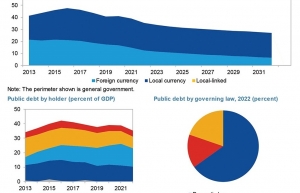Public debt indicators remain in alignment with expectations
New estimates by the government suggest that total public debt in 2024 will be about 36-37 per cent of GDP, below the target of 39-40 per cent, and similar to the 37 per cent recorded in 2023. Government debt is forecasted at 33-34 per cent of GDP, maintaining the same level as last year. Additionally, external debt is projected to be 32-33 per cent of GDP, slightly lower than the 33.5 per cent recorded previously.
 |
| A strong public debt outlook is underpinned by state budget performance, photo Le Toan |
By the end of 2025, total public debt is expected to remain at 36-37 per cent of GDP, still well below the 60 per cent threshold, while government debt will be 34-35 per cent of GDP, comfortably under the 50 per cent limit. Foreign debt is also expected to hover around 33-34 per cent of GDP, within safe limits.
The government emphasised that these public debt indicators are aligned with the permissible levels set, thus continuing to ensure national financial security. The positive outlook on public debt management is largely underpinned by a strong state budget performance this year.
Data from the General Statistics Office show that during the first nine months of 2024, state budget revenues reached $60.34 billion, an increase of nearly 18 per cent on-year, while total expenditures stood at $52.34 billion, up only 1.4 per cent on-year. This generated an $8 billion surplus in the state budget, reflecting effective fiscal management.
The nine-month expenditures have supported a wide range of socioeconomic development activities, including security, defence, state management, and local recovery efforts following Typhoon Yagi. Additionally, the state ensured timely payments of debts and other obligations as mandated by regulations.
In terms of revenue structure, domestic revenues for September were estimated at $3.08 billion, raising the cumulative nine-month total to $50.13 billion, a 19 per cent on-year increase, accounting for 83 per cent of total state budget revenues. This reflects robust domestic economic activity, as the government collected revenues from various sources such as taxes, fees, and capital contributions from state-run enterprises, as well as revenue from leasing land and water surfaces, and also from selling the state’s assets.
Export-import activities also contributed significantly to state revenues. In September, revenue from goods exports and imports stood at $641.7 million, bringing the nine-month total to $8.34 billion, a 17.6 per cent increase on-year, accounting for 13.8 per cent of total state budget revenues.
Despite these gains, the government anticipates a state budget deficit for the entire year. Total revenues are expected to reach over $78 billion, exceeding the initial target of $68.75 billion and surpassing the $73.08 billion achieved last year. However, expenditures are expected to rise to $95.07 billion, higher than the initial goal of $85.4 billion, and surpassing last year’s total of $87.9 billion. As a result, the deficit for 2024 is projected to be around $17.7 billion.
The government expects total state budget revenues to rise to nearly $82 billion next year, with expenditures reaching $105.32 billion. This would result in a state budget deficit of $23.32 billion. The government has stated that these expenditures will meet the demands of investment in critical national infrastructure, salary payments for public employees, and implementation of existing policies.
Despite the projected overspending, all indicators related to public debt, government debt, and external debt are expected to remain within safe and permissible limits, ensuring continued financial security. The government also stressed the importance of utilising available fiscal space in public debt, government debt, and budget deficits, which are still below the permissible limits, to mobilise additional resources for national development, particularly through the issuance of government bonds to fund strategic infrastructure projects.
The eighth session of the 15th National Assembly will open in Hanoi this week, running for four weeks in two phases. The first phase will last from October 21 to November 13, with the second phase scheduled for November 20-30.
The session will feature four additional agenda items, including reviewing and approving amendments to the Law on Officers of the Vietnam People’s Army and the Law on Health Insurance, as well as considering the draft Law on Data and the investment policy for a North-South high-speed railway.
Lawmakers will also discuss 26 legislative matters, nine groups of socioeconomic topics, state budget oversight, and other critical issues. Additionally, 12 groups of topics will be submitted for consideration during this session.
 | Public debt plan laid out towards 2026 Vietnam’s scheme for borrowing and paying public debt has been outlined, with diverse sources of loans in the pipeline and public debt set to stay within the permissible limit. |
What the stars mean:
★ Poor ★ ★ Promising ★★★ Good ★★★★ Very good ★★★★★ Exceptional
Related Contents
Latest News
More News
- Banks gear up for massive capital increases (December 18, 2025 | 17:04)
- Securing capital and efficiency for Vietnam’s 2026-2030 growth ambitions (December 17, 2025 | 10:00)
- Energy sector in need of blended finance mechanisms (December 17, 2025 | 09:00)
- Vietnam still has room to mobilise capital for sustainable growth (December 17, 2025 | 08:57)
- Long-term capital seen as key hurdle to green growth (December 16, 2025 | 08:00)
- Gold prices swing amid tax debate and import uncertainty (December 15, 2025 | 18:04)
- Agribank frames bank credit as catalyst for green growth (December 15, 2025 | 17:59)
- Vietnam’s green transition demands collective financial action (December 15, 2025 | 12:00)
- VIR workshop highlights capital and policy for sustainable development (December 15, 2025 | 11:00)
- Promoting digital assets initiative in Vietnam (December 13, 2025 | 09:30)

 Tag:
Tag:






















 Mobile Version
Mobile Version